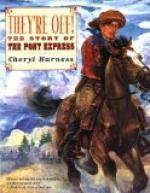Charles Cliff had an eighty-mile pony run when only seventeen years of age, but, like Brink, young Cliff gained his greatest reputation as a fighter, — in his case fighting Indians. It seems that while Cliff was once freighting with a small train of nine wagons, it was attacked by a party of one hundred Sioux Indians and besieged for three days until a larger train approached and drove the redskins away. During the conflict, Cliff received three bullets in his body and twenty-seven in his clothing, but he soon recovered from his injuries, and was afterward none the less valuable to the Pony Express service.
J. G. Kelley, later a citizen of Denver, was a veteran pony man. He entered the employ of the company at the outset, and helped Superintendent Roberts to lay out the route across Nevada. Along the Carson River, tiresome stretches of corduroy road had to be built. Kelley relates that in constructing this highway willow trees were cut near the stream and the trunks cut into the desired lengths before being laid in place. The men often had to carry these timbers in their arms for three hundred yards, while the mosquitoes swarmed so thickly upon their faces and hands as to make their real color and identity hard to determine.
At the Sink of the Carson[26], a great depression of the river on its course through the desert, Kelley assisted in building a fort for protecting the line against Indians. Here there were no rocks nor timber, and so the structure had to be built of adobe mud. To get this mud to a proper consistency, the men tramped it all day with their bare feet. The soil was soaked with alkali, and as a result, according to Kelley’s story, their feet were swollen so as to resemble “hams.”
They next erected a fort at Sand Springs, twenty miles from Carson Lake, and another at Cold Springs, thirty-two miles east of Sand Springs. At Cold Springs, Kelley was appointed assistant station-keeper under Jim McNaughton. An outbreak of the Pah-Ute Indians was now in progress, and as the little station was in the midst of the disturbed area, there was plenty of excitement.
One night while Kelley was on guard his attention was attracted by the uneasiness of the horses. Gazing carefully through the dim light, he saw an Indian peering over the outer wall or stockade. The orders of the post were to shoot every Indian that came within range, so Kelley blazed away, but missed his man. In the morning, many tracks were found about the place. This wild shot had probably frightened the prowlers away, saving the station from attack, and certain destruction.




